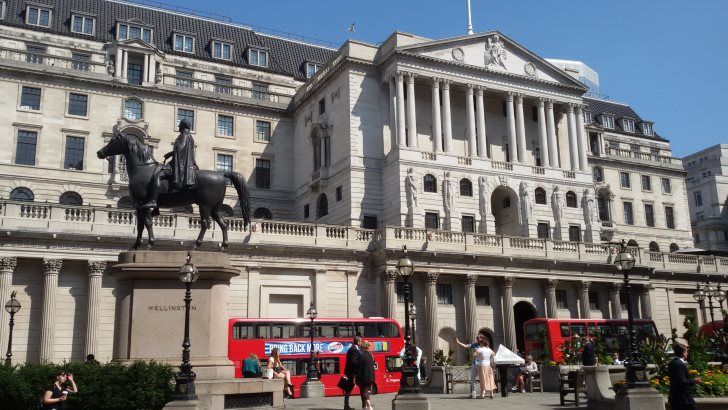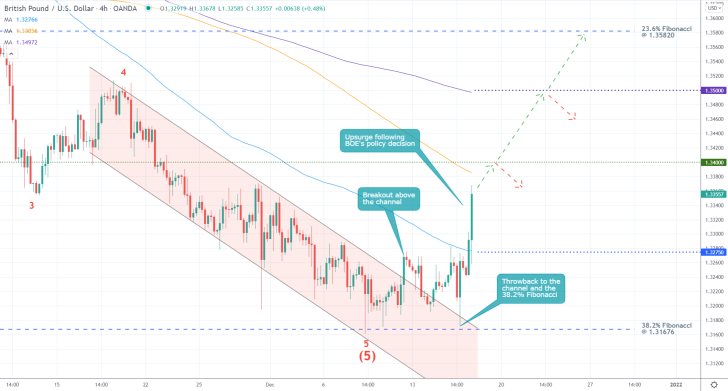
The pound was propelled higher after the Monetary Policy Committee (MPC) of the BOE decided to increase its interest rate. This decision catalysed a long-expected trend reversal on the GBPUSD. Read more about the dollar's weakness from our comprehensive EURUSD analysis.
In a surprising move, the MPC of the Bank of England, chaired by Andrew Bailey, decided to lift its interest rate to 0.25 per cent and keep its asset purchase facility unchanged at 875 billion. This caused the pound to rally in the short term.

As can be seen on the 4H chart above, the GBPUSD had already started establishing a trend reversal before BOE's decision. The previous downtrend was terminated at the 38.2 per cent Fibonacci retracement level at 1.31676.
This also marked the completion of a major 1-5 impulse wave pattern, as postulated by the Elliott Wave Theory. The breakout above the descending channel was also catalysed by the dollar depreciation that resulted from FED's policy decision from yesterday.
Immediately following BOE's policy decision, the GBPUSD broke out above the major resistance-turned-support level at 1.32750, underpinned by the 100-day MA (in blue). The price action is currently headed towards the next major support at 1.34000, which was just crossed by the 200-day MA (in orange).
If the bullish sentiment persists, then the new uptrend is likely to head further up north towards the 23.6 per cent Fibonacci at 1.35820. However, it would first have to break the major resistance at 1.35000, whose strength is underscored by the 300-day MA (in purple).
BOE's surprising move to lift its interest rate at present
The Monetary Policy Committee voted by a majority of 8-1 to increase #BankRate to 0.25% and by a majority of 9-0 to maintain the amount of quantitative easing at £895bn. https://t.co/8N5Szd2mD3 pic.twitter.com/b7rsd11fi8
— Bank of England (@bankofengland) December 16, 2021
Eight members of the Committee voted in favour of the motion, with only one abstaining. The market forecasts were anticipating only two members to agree to such a hawkish decision at the present rate. Meanwhile, a uniform decision to maintain the asset purchase facility unchanged was also unexpected.
"The level of global GDP in 2021 Q4 is likely to be broadly in line with the November Report projection, but consumer price inflation in advanced economies has risen by more than expected. The Omicron variant poses downside risks to activity in early 2022, although the balance of its effects on demand and supply, and hence on medium-term global inflationary pressures, is unclear. Global cost pressures have remained strong."
Trendsharks Premium
Gold is undergoing a correction, as investors take profits to offset losses from falling stock prices, impacting their margins. However, we anticipate a renewed wave of [...]
The Swiss stock market index is mirroring its global counterparts, such as Germany 40 and US100, experiencing a sharp decline following the announcement of new [...]
We’re analyzing the weekly chart to grasp the broader market trend. Over the past three years, the US30 index has surged by 17,000 points, often resembling a nearly straight [...]
Over the past week, the DAX has experienced a sharp decline, plunging by an astonishing 3,400 points. This downward movement is not isolated, as its international counterparts, such as the UK100 and US100, are also facing significant [...]
EURUSD recently formed a double top at 1.0930, signaling a potential trend reversal, and has since begun a correction. After a 600-pip rally since early March, a pullback at this stage is both expected and healthy. Given these conditions, we are placing a [...]
Since early March, EURJPY has surged nearly 1,000 pips, providing us with several excellent trading opportunities. However, as the rally matures, many early buyers are beginning to take profits, leading to a noticeable slowdown in the uptrend. On Friday, the pair formed a [...]
The AUDJPY currency pair continues to be dominated by bullish momentum, as multiple golden cross patterns reaffirm the strength of the ongoing uptrend. Despite this, we are witnessing a much-needed [...]
The EURAUD currency pair appears to be undergoing a trend reversal, signaling a potential shift in market direction. A notable technical development is the formation of a Death Cross on the chart, a widely recognized bearish indicator that typically suggests a [...]
After securing an impressive 200-pip profit last week, the EURJPY currency pair is now undergoing a southward correction, retracing some of its recent gains. Despite this temporary pullback, the Golden Cross remains intact, reinforcing our view that the overall trend continues to be [...]
The appearance of a Golden Cross in Silver strengthens our analysis that the metal is currently in a strong uptrend, indicating further bullish momentum in the market. This technical pattern, where the short-term moving average crosses above the [...]
This trade presents a considerable level of risk and can be classified as an opportunistic move based on recent price action. The GBPUSD currency pair has experienced a substantial bullish rally, surging by nearly 500 pips in a strong upward movement. However, after this extended period of appreciation, the pair is showing signs of a potential [...]
The anticipated Death Cross on the SMI20 appears to be failing as price finds strong support at the 23% Fibonacci retracement level. After testing this area, the index has shown bullish strength, printing several large green candles, signaling an increase in [...]
A Golden Cross has just appeared on the USDJPY chart, signaling a potential bullish move. This technical pattern occurs when the 20 period moving average crosses above the 60 period moving average, a widely recognized indication of increasing [...]
After 2 months of a down trend, we finally see some indications of price recovery for Oil. The golden cross, a historic buy signal, supports this [...]
For the past month, the German DAX40 has experienced a remarkable 10% surge, reflecting strong bullish momentum. Despite ongoing market volatility and frequent pullbacks, every dip continues to attract fresh buyers, reinforcing the [...]
Oil continues its downward trajectory, despite occasional pullbacks. The overall trend remains bearish, reinforced by multiple Death Cross patterns, a classic sell signal indicating further weakness. Adding to this bearish outlook, the critical [...]
Over the past few days, gold has experienced a sharp decline of more than $100. This downturn can be attributed in part to traders securing profits to manage their margins, which are under strain due to the significant drop in major indices. Currently, gold has fallen below the [...]
The NASDAQ 100 index is showing strong bullish momentum, as evidenced by the formation of a Golden Cross on the chart. This classic buy signal occurs when the short moving average crosses above the long term moving average, suggesting that upward momentum is [...]
The EURAUD currency pair has encountered a significant resistance level, failing to break above the critical 61% Fibonacci retracement level. This suggests that bullish momentum is weakening, reinforcing the case for a potential downward move. Given this technical setup, we favor entering a [...]
The UK100 is experiencing a remarkable rally! Over the past few weeks, the British stock market index has surged nearly 800 points. Each minor dip has attracted more buyers, fueling the bullish momentum. However, since last week, we’ve observed a slight [...]




















